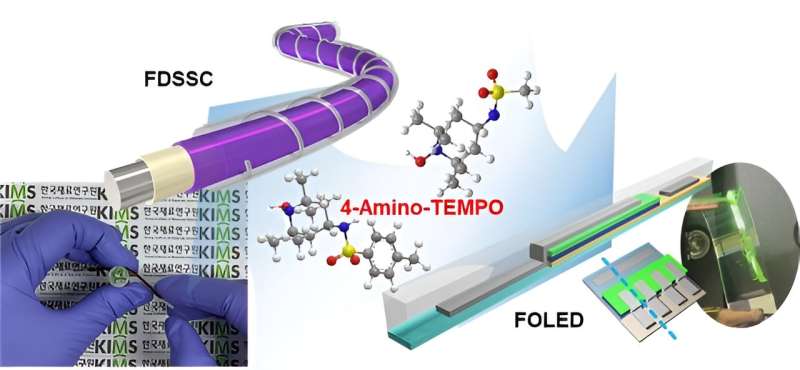This article has been reviewed according to Science X's editorial process and policies. Editors have highlighted the following attributes while ensuring the content's credibility:
fact-checked
trusted source
proofread
High performance and stability achieved with multifunctional materials for solar cells and organic light-emitting diodes

Through joint research, a team has developed a 4-Amino-TEMPO derivative with photocatalytic properties and successfully used it to produce high-performance and stable fiber-shaped dye-sensitized solar cells (FDSSCs) and fiber-shaped organic light-emitting diodes (FOLEDs). The paper is published in the journal Materials Today Energy.
The developed 4-Amino-TEMPO derivative has the characteristic of simultaneously improving the performance of both fiber-shaped dye-sensitized solar cells (FDSSCs) and fiber-shaped organic light-emitting diodes (FOLEDs).
Conventional materials are difficult to synthesize and mass produce, and the reproducibility of devices using them was poor. The 4-Amino-TEMPO derivative developed by the research team not only has a simple synthesis process and can be synthesized in large quantities, but also enhancing the performance of FDSSCs and FOLEDs, improving the performance of both electronic devices by more than 20%.
The research team, including Professor Chul-jin Ahn's team at Changwon National University, the research team of Dr. Jae-Ho Kim and Dr. Myung-kwan Song from the Department of Energy & Electronic Materials in the Surface & Nano Materials Division, designed and synthesized a material with photocatalytic properties to enhance the efficiency of FDSSCs.
The synthesized material exhibits high stability in both air and moisture, rendering it suitable for producing high-performance FDSSCs and FOLEDs. Furthermore, it was confirmed to possess excellent washing properties and resistance to mechanical shock.
4-Amino-TEMPO derivatives find application in various electronic device fields, including solid electrolytes in lithium batteries, catalysts, solar cells, and organic light-emitting diodes. What sets this technology apart is its capability for mass production through a straightforward process, coupled with its cost-effectiveness. Additionally, it offers multifunctionality rather than single-functionality, making it widely applicable across various electronic applications.
These derivatives can be mass-produced at a low cost, amounting to less than 1 million won per 100g. Leveraging this technology for local and mass production holds the potential for unprecedented economic benefits in electronic device companies.
Dr. Myung-kwan Song, the lead researcher for this study, stated "By leveraging multifunctional materials, we can enhance performance and bolster reliability in electronic device domains. We anticipate applications spanning diverse fields, including energy production and storage materials, as well as sensor materials."
The research team is continuing to conduct follow-up research to utilize 4-Amino-TEMPO derivatives in organic solar cells, perovskite solar cells, and organic light-emitting diodes, with the goal of mass production within a few years.
More information: Jae Ho Kim et al, Improved device performance with 4-amino-TEMPO derivatives for fiber dye-sensitized solar cells and organic light-emitting diodes, Materials Today Energy (2024). DOI: 10.1016/j.mtener.2024.101572



















